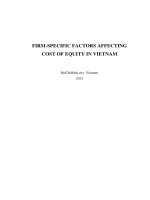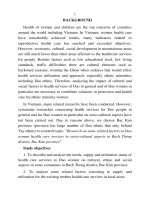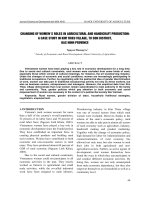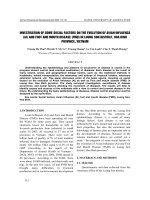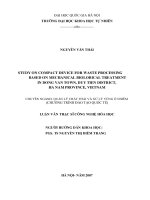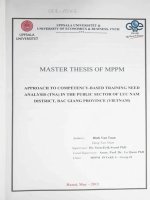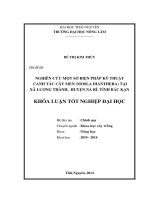Factors influencing multidimensional poverty of households in luong thuong commune na ri district bac kan province vietnam
Bạn đang xem bản rút gọn của tài liệu. Xem và tải ngay bản đầy đủ của tài liệu tại đây (977.06 KB, 72 trang )
MINISTRY OF AGRICULTURE AND RURAL DEVELOPMENT
VIETNAM NATIONAL UNIVERSITY OF FORESTRY
STUDENT THESIS
Title
FACTORS INFLUENCING MULTIDIMENSIONAL POVERTY OF
HOUSEHOLDS IN LUONG THUONG COMMUNE, NA RI DISTRICT,
BAC KAN PROVINCE, VIETNAM
Major: Natural Resources Management
Code: D850101
Faculty: Forest Resources and Environmental Management
Student: Nguyen Lan Huong
Student ID: 1453091144
Class: 59B Natural Resources Management
Course: 2014-2018
Advanced Education Program
Developed in collaboration with Colorado State University, USA
Supervisor: PhD. Le Dinh Hai
Ha Noi, 2018
Page | i
ABSTRACT
The investigative result of interviewing 150 households (including 75 poor
households and 75 non-poor households) in Luong Thuong commune, Na Ri district, Bac
Kan province shows that the main causes on multidimensional poverty of households in
study area include: (1) Average land area of the household, (2) Ability to access
information by households, (3) Participation in agriculture extension activities, (4)
Ethnicity of household head, and (5) Number of dependant in the household.
Based on this study, five groups of solution were proposed to contributorily help
households in study area escape from poverty, including (1) Increasing the land area of the
household (2) Improved access information for households (3) Renovation of agricultural
extension (4) Sustainable poverty reduction for ethnic minorities (5) Reducing the number
of dependants in the household. These solutions can be used as valuable reference
materials for determining policies of sustainable poverty-reduction for ethnic minority in
Luong Thuong commune in particular and in Bac Kan province in general.
Keywords: multdimensional poverty, poverty escape, poverty relapse
ii
ACKNOWLEDGEMENTS
The first person that I would appreciate is my advisor Dr. Le Dinh Hai, whom
without, the study could not have been possible, for orientating me to tackle tough issues in
fieldwork as well as at school, for expanding my knowledge and fulfilling my skills. For
giving me uncountably helpful support and devoted guidance throughout the entire thesis
researching process.
I would also thank useful materials in Google that developed my understanding and
background in statistical methods - a part of The Natural Resource Management sector.
Besides, I owe my friends and teachers in The Faculty of Forest Resources and
Environmental Management for making a wonderful educating environment for me to
study and thrive.
My thesis would not be completed and perfect without the kindness of authorities
and civilians in Luong Thuong commune, Na Ri district. Data and information about
agriculture, society, economy, and climate of the area were cumulated by their unrelenting
support. Additionally, I am also grateful to forest rangers in Kim Hy Natural Reserve and
Nam Xuan Lac Natural Reserve whom I have received their copious instructions about
problems relating to my thesis, ranging from knowledge of forestry to feasible sustainable
agriculture, from field surveys and data collection in the locality.
And finally, I want to deliver my gratitude to my family and colleagues in Action
for Wildlife Organization. They are my greatest source of motivation and energy, as well
as the firmest foundation supporting me to pursuit my academic career.
Ha Noi, September 2018
Nguyen Lan Huong
iii
CONTENTS
MINISTRY OF AGRICULTURE AND RURAL DEVELOPMENT ................................... i
ABSTRACT...........................................................................................................................ii
ACKNOWLEDGEMENTS ..................................................................................................iii
CONTENTS.......................................................................................................................... iv
LIST OF ABBREVIATIONS .............................................................................................. vii
LIST OF TABLES ..............................................................................................................viii
LIST OF FIGURES .............................................................................................................. ix
CHAPTER 1: INTRODUCTION .......................................................................................... 1
CHAPTER 2: STUDY GOALS AND OBJECTIVES .......................................................... 4
2.1.
Goal ............................................................................................................................. 4
2.2.
Specific objectives ...................................................................................................... 4
CHAPTER 3: LITERATURE REVIEWS ............................................................................. 5
3.1.
Biophysical conditions ................................................................................................ 5
3.1.1.
Geographic location and topography ...................................................................... 5
3.1.2.
Climate .................................................................................................................... 7
3.1.3.
Natural resources ..................................................................................................... 8
3.2.
Socio-economic conditions ......................................................................................... 8
3.2.1.
Population ............................................................................................................... 8
3.2.2.
Economy ................................................................................................................. 9
CHAPTER 4: RESEARCH METHODS ............................................................................. 10
4.1.
Research framework ................................................................................................. 10
4.2.
Theoretical basis ....................................................................................................... 11
4.2.1.
Relevant concepts.................................................................................................. 11
4.2.2.
Multidimensional poverty measurement indicators .............................................. 14
4.2.3. Regulations and methods of identifying multidimensional poor households in
Vietnam ................................................................................................................................ 15
iv
4.3. Framework of potential factors affecting multidimensional poverty of the
households ........................................................................................................................... 18
4.3.1. Ethnicity ..................................................................................................................... 19
4.3.2. Gender of household head ......................................................................................... 20
4.3.3. Age of household head .............................................................................................. 21
4.3.4. Household size ........................................................................................................... 21
4.3.5. Dependent .................................................................................................................. 22
4.3.6. Education of household head ..................................................................................... 22
4.3.7. Land area.................................................................................................................... 23
4.3.8. Occupation of household head ................................................................................... 24
4.3.9. Agricultural extension................................................................................................ 24
4.3.10. Households borrowed money from the bank ........................................................... 25
4.3.11. Access information .................................................................................................. 26
4.4. Data Collection method ................................................................................................ 26
4.5. Data analysis method .................................................................................................... 29
4.5.1. Descriptive Statistics.................................................................................................. 29
4.5.2. Comparative analysis ................................................................................................. 30
4.5.3. Binary Logistic Regression ........................................................................................ 30
CHAPTER 5: RESULT ....................................................................................................... 35
5.1. Descriptive statistics on surveyed households .............................................................. 35
5.1.1. Ethnicity of household head ...................................................................................... 35
5.1.2. Gender of household head ......................................................................................... 36
5.1.3. Occupation of household head ................................................................................... 37
5.1.4. Participation in agriculture extension activities ......................................................... 37
5.1.5. Households borrowed money from the bank ............................................................. 39
5.1.6. Ability to access information by households ............................................................. 39
5.1.7. Age of household head .............................................................................................. 41
5.1.8. Household size ........................................................................................................... 42
v
5.1.9. Number of dependant in the household ..................................................................... 42
5.1.10. Education of the household head ............................................................................. 43
5.1.11. Average land area of the household ......................................................................... 43
5.2. Factors influencing multidimensional poverty in Luong Thuong commune ............... 44
CHAPTER 6: DISCUSSION............................................................................................... 47
6.1. Discussion ..................................................................................................................... 47
6.1.1. Land area of the households ...................................................................................... 47
6.2.2. Access to information for households ....................................................................... 48
6.2.3. Agricultural extension................................................................................................ 49
6.2.4. Ethnicity ..................................................................................................................... 49
6.2.5. Dependant .................................................................................................................. 50
6.2. Proposed solutions ........................................................................................................ 50
6.2.1. Increasing the land area of the households ................................................................ 50
6.2.2. Improving access to information for households ....................................................... 51
6.2.3. Renovation of agricultural extension ......................................................................... 51
6.2.4. Sustainable poverty reduction for ethnic minorities .................................................. 52
6.2.5. Reducing the number of dependants in the household .............................................. 54
CHAPTER 7: CONCLUSION ............................................................................................ 55
REFERENCES .................................................................................................................... 56
APPENDIXES: PICTURES OF THE FIELD TRIP ........................................................... 59
vi
LIST OF ABBREVIATIONS
DFID
Department for International Development
ESCAP
Economic and Social Commission for Asia and the Pacific
FAO
Food and Agriculture Organization of the United Nations
HDI
Human Development Index
MPI
Multidimensional Poverty Index
OPHI
Oxford Poverty & Human Development Initiative
SPSS
Statistical Package for the Social Sciences
UN
United Nation
UNDP
United Nations Development Programme
VND
The ISO 4217 currency code for the Vietnamese Dong.
WTO
World Trade Organization
vii
LIST OF TABLES
Table 4.1. Levels of poor households, near-poor households and medium households
applicable during 2016-2020 ................................................................................. 17
Figure 4.4. The difference between Kinh and ethnic minority poverty widens. ................. 19
Figure 4.5. Description of a vicious poverty circle. Source: Rao và Chopra (1991) ........... 22
Table 4.2. Characteristics of surveyed households by criteria of capital-loan scale. .......... 25
Table 4.3. Sampling design in Na Ri district, Bac Kan province ........................................ 27
Table 4.4. Time for field surveys ......................................................................................... 28
Table 4.5. Interpretation of variables in the Binary Logistic Regression ............................ 32
Table 5.1. Relationship between independent variables and household belongs to
multidimentional group ......................................................................................... 35
Table 5.2. Description of quantitative variables .................................................................. 41
Figure 5.7. Percentage of dependency between poor households and non-poor households
............................................................................................................................... 42
Figure 5.8. Education level of household heads in Luong Thuong commune .................... 43
Figure 5.9. Comparing the average area between poor households and non-poor
households. ............................................................................................................ 44
Table 5.3. Model summary for factors influencing multidimensional poverty ................... 45
Table 5.4. Determining importance of variables in Binary Logistic Regression model ..... 46
viii
LIST OF FIGURES
Figure 3.1. Map of study location ......................................................................................... 6
Figure 4.1. Research framework .......................................................................................... 10
Figure 4.2. The indicators of the Global MPI ...................................................................... 15
Figure 4.3. Conceptual model for potential factors influence multidimensional poverty of
households in Luong Thuong commune ............................................................. 18
Figure 5.1. Gender of household head ................................................................................. 36
Figure 5.2. Occupation of household head .......................................................................... 37
Figure 5.3. Participation in agriculture extension activities ................................................ 38
Figure 5.4. Households borrowed money from the bank .................................................... 39
Figure 5.5. Percentage of ability to access information by households ............................... 40
Figure 5.6. Percentage of ability to access information by households between poor
households and non-poor households ................................................................. 41
ix
CHAPTER 1: INTRODUCTION
Poverty is a paradoxical state. Recognizable in the field for any sensitive observer
who travels in remote rural areas and urban slums and meets marginalized people in a
given society, poverty still remains a challenge to conceptual formalization and to measurement
that is consistent with such formalization. The analysis of poverty is multidisciplinary. It goes
from ethics to economics, from political science to human biology, and any type of measurement
rests on mathematics (Louis-Marie Asselin, 2009) [17].
In order to comprehensively assess household poverty, household poverty studies
should be considered and analyzed according to different criteria. Thus, in addition to
traditional research methods, the assessment of household poverty is based not only on the
common criteria of income and expenditure, but also on the level of "multidimensional
poverty" through the social aspects of residential life with the gaps that they may face such
as social security, education, health, housing, social security, and security.
Because of that, in recent years, the Multidimensional Poverty Index has been used
by scientists around the world as a tool to identify poor households and, on that basis,
proposes solutions to reduce poverty.
At present, nearly 2 billion people in Vietnam still live in poverty, lacking basic
education, nutrition, and health. Poverty is one of the major barriers to the equalization of
human, community and national development. Poor people often have no access to social
services such as employment, education, healthcare, information and so on. That makes
them less likely to escape poverty.
1
In order to successfully implement the hunger eradication and poverty alleviation,
the government has implemented a number of concrete policies and programs of action, as
well as in-depth studies on the causes of poverty. Since then, solutions to poverty reduction
have also been explored by experts and scientists. In Vietnam, multidimensional poverty
studies are not well developed and multidimensional poverty approaches are beginning to
be approached [18].
Bac Kan is a mountainous province located in the northeast of the north with a
natural area of 4,859.41 km2, in which agricultural land is 3,721.868 km2 and another land
is 958.39 km2. There are 7 districts, 1 city with 122 communes, wards, towns in which 50
communes belong to the area III, 27 communes belong to the area II and 45 communes
belong to the area I [1]. There are 1,421 villages and residential area. There are 2 poor
districts assisted by the Program 30a and 58 especially difficult communes inherit from the
Program 135. The population is 308,310 people including 7 ethnicities (Tay, Dzao, Nung,
H‟Mong, Hoa, San Chay, Kinh), in which ethnic minority accounts for over 86% (Tay:
52.93%; Dzao: 17.63%; Nung: 9.36%; H‟Mong: 5.95%; Hoa: 0.36%; San Chay: 0.2%;
others: 0.2%) (2016) [2].
The rate of poor household is considered highest in Vietnam. In the past few years
of conducting the program of poverty reduction, with a tireless effort of departments,
authorities, stakeholders and provincial residents, the affairs of reducing poverty have
acquired some certain achievements. The rate of poor household reduced from 32.13% in
2011 down to 11.63% (reduce averagely 4.10% per year). The rate of near-poor
households reduced from 16.93% in 2011 down to 7.91% (reduce averagely 1.80% per
year) [3]. This is a considerable effort of authorities of the executive committee (of party
hierarchy), The Vietnamese Fatherland Front, departments, organizations, incorporations
in the conduction of poverty reduction.
2
However, the poverty-escaping households are not really sustainable, the risk of repoverty is still high, the number of poor households is large, the conduction of poverty
reduction meets increasingly more difficult. The reduction rate of poor household is low,
the rate of trained laborers is small, there are still unemployed people. Scientific
application into practice is still limited. Investment and construction progress of
infrastructure in difficult communes is still inadequate, the rate of disbursement is still low.
The conduction of poverty reduction and hunger elimination (by the national target
program of districts and cities) most concentrated on assisting directly plants and pets,
fertilizer supplies, buying machines or equipment, building farming cages, improving
ponds for the poor and near-poor households but lacking building marked model to expand
the scale.
The study aims to identify the main factor influencing multidimensional poverty of
households and propose solutions to overcome poverty in Luong Thuong commune, Na Ri
district, Binh Phuoc province. The findings of this study, therefore, provide implications
for developing solutions in the strategy of sustainable poverty reduction in the study area.
In that context, I decided to conduct the project “Factors influencing multidimensional
poverty of households in Luong Thuong commune, Na Ri district, Bac Kan province,
Vietnam”.
3
CHAPTER 2: STUDY GOALS AND OBJECTIVES
Goal
The goal of this study is to analyze factors influencing multidimensional poverty of
households in Luong Thuong commune and propose solutions to reduce multidimensional
poverty of households in the study area.
Specific objectives
To review potential factors that affect multidimensional poverty of households.
To identify the factors that significantly affect multidimensional poverty of
households in the study area.
To propose soulutions to reduce multidimensional poverty of households in the
study area.
4
CHAPTER 3: LITERATURE REVIEWS
3.1. Biophysical conditions
3.1.1. Geographic location and topography
Geographic location
Luong Thuong commune is located in the north of Na Ri district, about 24 km from
the district center and 63 km from the north of Bac Kan City, with geographical
coordinates: 22o16'42'' North latitude; 106o4'26'' East longitude. This commune is divided
into 5 villages: Khuoi Noc, Na Lang, Vang Khit, Pan Xa, and Ban Giang. The total natural
area is 3,794.23 ha with the population of 2,036 people.
- The East borders on Lang San commune.
- The South borders on Lang San, An Tinh and Kim Hy commune.
- The West borders on Kim Hy commune.
- The North borders on Thuan Mang and Thuong Quan commune.
5
Figure 3.1. Map of study location
6
Topography
Luong Thuong is the commune that Bac Giang River flows across and the national
road 279 is lengthened across roughly 7 km, dividing the communal topography into 2
distinct parts: One stone-mountainous half belongs to Kim Hy Natural Reserve, one other
half borders forested hill which accounts for 70% of the total natural area. In general, the
soil in Luong Thuong commune is infertile, low at humus quantity. Soil for paddy field has
thin cultivation layers. Forested land owns medium surface layer, suitable for forestry
trees. The commune‟s topography is mainly highly mountainous with fairly large paddy
fields along Bac Giang River and ravines. There are a number of interleaving creeks with
an average height of 300 – 700 m.
3.1.2. Climate
Luong Thuong commune is located within the tropical belt of the monsoon
Southeast region. In this location, there is a clear climate differentiation by seasons. The
tropical monsoon climate is combined with topographical differentiation by height. The
climatic regime is divided into 2 distinct seasons: rainy hot season lasts from April to
October, dry season lasts from November to the March of the next month.
The annual average temperature is about 21oC, reaching the highest with 37oC,
falling down to the lowest with 5oC [31]. The yearly average temperature is 1,084 mm, the
rainfall reaches the highest in May, June, and July (averagely from 186.2 mm/month to
242.0 mm/month), the rainfall is lowest in November and December. The total of average
sunny hours per year is 1,483.0 hours, reaching the highest in June, July and August with
averagely 185 hours, falling down to the lowest in January with averagely 61 hours.
The average moist is approximately 82%, reaching the least in February and March
with 785 mm, reaching up to the highest in August and September with 87%. The yearly
7
average amount of evaporating is 840 mm, reaching the highest in April with 77 m and
falling down to the least in February with 65.4 mm.
In terms of wind and storm: Luong Thuong is a mountainous commune covered by
high mountain ranges so the wind direction is uncertain. The local place is also affected by
the Northeast climate so affected by Northeast and Southwest wind.
Generally, climate and weather in the commune are relatively appropriate for daily
life and agriculture-forestry production of the local people. However, the commune is
influenced by rocky mountain so it is foggy and drizzling in the winter. In dry season, there
is drought. In rainy season, due to high terrain and steep slope, it rains heavily, leading to
flooding, erosion, a landslide in hill and mountain range.
3.1.3. Natural resources
Due to plantation diversity and highly covered surface, humus amount is rather
large. Three main types of soil can be classified by material compositions:
- The yellow humus feralit: Yellow humus feralit develops on magma, alumina-rich
sedimentary rocks. This type of soil is mainly used for forestry and industrial crops.
- Humus-rich limestone soil developed on steep slopes near the carbonate rocks. It
occupies a small area and is used for forestry and horticultural crops.
- Sediment soil is distributed in river valleys and ancient steps. The area is not
large, used for growing food, crops, and garden.
3.2. Socio-economic conditions
3.2.1. Population
According to Communal People of Luong Thuong commune by 2015, the total of the
population in Luong Thuong is 426 households comprising 2,036 inhabitants. Density
population distribution of 52 people/km2.
8
There are 5 ethnic groups: Tay, Nung, Kinh, H‟Mong, and Dzao. Besides Kinh
language, Tay and H‟Mong are the 2 languages mainly used. The inhabitants of Luong
Thuong commune live in five villages: Khuoi Noc, Na Lang, Vang Khit, Pan Xa, and Ban
Giang.
At present, there are still 175 poor households, accounting for 37,7%; Near-poor
households are 89 ones, accounting for 19,18% (2017).
In general, the fluctuation of the population in Luong Thuong commune in the past
few years was not considerable. Mostly due to agriculture production, the number of
immigrants and emigrants are not very fluctuating.
3.2.2. Economy
The structural rate of silviculture accounts for 97.79%. The service commerce
accounts for 2.13% [4].
Agriculture: The area of growing rice all the year is 290.7 ha the average
productivity is 5,250 weight/ha. For raising cattle, there are 181 individuals in cow/buffalo
herd, 950 pigs and 5,500 poultry individuals.
Forestry: The forest coverage reaches 75% roughly, 12-15 ha of forest area is
expanded every year for production serving.
Commerce and service: there are 30 households trading on commercial service,
food, and drink service.
9
CHAPTER 4: RESEARCH METHODS
4.1. Research framework
Figure 4.1 represents the whole process of doing the analysis work:
Figure 4.1. Research framework
Step 1: Theory base is the theoretical foundation to lead to the issues to be
studied. Theory base for multidimensional poverty of households includes concepts related
to multidimensional poverty, multidimensional poverty measurement indicators, and
regulations for identifying multidimensional poor of households in Vietnam
Step 2: The framing of factors affecting household poverty is an important part
of this study. From identifying potential factors that affect poverty, we can assess the
multidimensional poverty of households in the locality.
Step 3: Data collection method and data analysis method are crucial aspects of
any type of study. Inaccurate data collection and data analysis can affect the final results of
a study and eventually lead to invalid results.
10
Step 4: Analysis of regression models is an important step to present the results
of the study. In this step, the regression analysis demonstrates the factors that will directly
affect the multidimensional poverty of households and which factors do not affect
household multidimensional poverty.
Step 5: The study aims to identify the main factor influencing multidimensional
poverty of households and propose solutions to overcome poverty in the study area.
Therefore, the development of solutions in the sustainable poverty reduction strategy is the
last step in research framework.
4.2. Theoretical basis
4.2.1. Relevant concepts
Poverty concept
There is no single concept of poverty. There is no perfect way to measure poverty.
It is possible, however, to define poverty as a condition in which a part of the population
does not enjoy and satisfy the basic needs of the person whose social needs are recognized
according to the level of socio-economic development, associations and local customs or
criteria of a country (as defined by ESCAP). "Poverty is a lack of opportunity to participate
in community development processes," said Abapia Sen, who won the Nobel economics
prize in 1998.
The conference against poverty in the Asia-Pacific organized by ESCAP in
Bankok, Thai Lan in September, 1993 gave a definition that: “Poverty is the state in which
part of residents cannot be satisfied with basic human demands that are admitted by
society, dependent on economic-social development, local cultures and tradition [5]”.
Besides, the poverty is also defined to be the situation in which part of residents lives
under the average living standard of community. This definition has a connection to social
11
inequality issue [6]. The average living standard is different amongst countries, regions,
etc, so understanding of poverty just has relative meaning, cannot be applied for all cases.
According to UN, poverty is minimum lac of ability to participate effectively in
social activities. Poverty is lack of food, clothes, study condition, medical service,
production land, job and access to credit. Poverty is also the shortage of safety and rights in
which individuals, households and communities are in the risk of being eliminated. Poverty
is the risk of getting violence, living out of the social margin or in bad conditons that the
poor can not assess clean water and clean sanitary construction (UN, June 2018, being
passed by leaders of organizations).
Multidimensional poverty concept
Since the socialization of mankind takes place in possession of material goods, the
separation of the rich and the poor has begun. For a long time, however, we often talked
about poverty as a part of the population, whose average income was less than $ 1 a day in
the 1990s; is now less than $ 2 per day per person per World Bank standard [7]. Thus, it is
clear that we have only looked at the numbers that have inadvertently forgotten the causes
of poverty, in which the most important is perhaps the “inequality” and the “power gap”
between individuals and between groups of people in society.
Based on this point of view, the concept of “multidimensional poverty” has
emerged, in which poverty is defined not simply as hunger, lack of food, or lack of living
conditions and other living conditions. Social barriers and other factors prevent individuals
or communities from accessing resources, information and services. Poverty is not just an
individual. They are the factors that inhibit the individual from accessing resources or do
not know and can not find solutions for themselves to get out of the existing poverty.
12
Multidimensional poverty is based not only on income but also on issues related to
education, culture, health, living standards, vulnerability, lack of right to speak and small
arms.
The OPHI: “Multidimensional poverty is made up of several factors that constitute
poor people’s experience of deprivation – such as poor health, lack of education,
inadequate living standard, lack of income (as one of several factors considered),
disempowerment, poor quality of work and threat from violence” [19].
Traditionally economists and policy analysts have focussed on money-metric
measures of poverty, based on the assumption that a person‟s material standard of living
largely determines their well-being. The poor are then defined or identified as those with a
material standard of living as measured by income or expenditure below a certain level the so-called poverty line (see Atkinson, 1987, 1989 and Ravallion, 1992). Practical
problems, largely associated with the difficulty of accurately quantifying income or
expenditure, have recently led to the exploration of alternative, non-monetary, proxies for
household welfare. Prominent amongst these is the use of household asset indexes i.e. an
aggregate measure of the access to, and ownership of, a specified list of household
attributes (Filmer and Pritchett, 1998; Montgomery et al, 1999; Sahn and Stifel, 2000)
(DFID) [20].
The above definition indicated agreement amongst nations, philosophists, and
learners that: Poverty is a multidimensional phenomenon and viewed as a shortage of basic
human demands [8]. The definition and measurement of poverty are subject to debate and
controversy. The level of poverty found at any one time in any one country is critically
dependent upon assumptions concerning the choice of welfare indicator (whether to use
household income or expenditure), the choice over how to take differences in households‟
sizes and compositions into account, and the choice of the appropriate poverty line to use.
13
It is increasingly recognized that poverty measures based on household income or
expenditure reflect a static concept, offering only a limited picture of household wellbeing. Recognition that monetary measures fail to capture other important dimensions such
as community resources, social relations, culture, personal security, and the natural
environment. Poverty is often determined by one-way measures, such as income but no
indicator can capture many of the dimensions of poverty.
In Vietnam, the concept of multi-dimensional poverty is new. This approach is to
develop a set of multidimensional poverty criteria with a more comprehensive view of the
present picture of poverty. At the same time, it will help relevant agencies to work out
practical policies aimed at reducing poverty more thoroughly and sustainably. Accordingly,
the poor are divided into many ages, according to the multidimensional poverty lines they
are facing so that the state and the organizations focus on removing, providing practical,
non-duplicative and more effective poverty reduction
4.2.2. Multidimensional poverty measurement indicators
Multidimensional poverty is not only manifested in the lack of food and lack of
money, but also reflected in the living standards of the people. Since 1997, UNDP has used
the HDI to measure people's living standards, including three factors: life expectancy,
education and income. Since 2010, the UN has adopted a new approach to measuring
poverty in a more comprehensive way, including monetary and non-monetary elements. It
called Multidimensional Poverty Index (MPI) which was created by Sabrina Alkire and
Maria Emma Santor (two experts from OPHI). The MPI covers directly the need,
vulnerability to health effects, education and essential services (such as clean water,
sanitation and energy). In some countries, day sources are provided at no cost or at a very
low cost while others exceed the level of the worker's income. The MPI measures the
poverty of OPHI in three dimensions and 10 indicators as shown in Figure 4.2 [34].
14
The Global MPI has three dimensions and 10 indicators, which are shown in the
box below. Each dimension is equally weighted, each indicator within a dimension is also
equally weighted, and these weights are shown in brackets within the diagram. Poor
households are missing at least 30% of the above indicators. Details of the indicators can
be found at the back of this briefing.
Figure 4.2. The indicators of the Global MPI
4.2.3. Regulations and methods of identifying multidimensional poor households in
Vietnam
Pursuant to the National Assembly's Resolution No. 76/2014/QH13 of June 24,
2014, on accelerated achievement of the sustainable poverty reduction goal by 2020. In
performance of the tasks assigned by the Government in Resolution No. 79/NQ-CP of
November 4, 2015, on the Government‟s October 2015 regular meeting. At the proposal of
the Minister of Labor, War Invalids and Social Affairs, the Prime Minister promulgates
multidimensional poverty levels applicable during 2016-2020 [33].
Based on review by assessment methods, grading property, collecting the
information about the characteristics and living conditions of the household to income
estimation and determine the level of lack of access to basic social services of poor
households and near-poor households. In short, norms for multidimensional poverty
15
measuring applicable during 2016-2020 includes income norms and norms on deprivation
of access to basic social services.
For income norm, poverty level is VND 700,000 / person / month and VND
900,000 / person / month in rural and urban areas, respectively; and near-poverty level is
VND 1,000,000 / person / month and VND 1,300,000 / person / month in rural and urban
areas, respectively.
For Norms on deprivation of access to basic social services, basic social services (5
services) consists of health; education; housing; clean water and sanitation; and
information. Additionally, indicators measuring die level of deprivation of access to basic
social services (10 indicators) are access to medical services; health insurance; education
level of adults; school attendance of children; housing quality; average housing area per
capita; residential water sources; hygienic latrines and toilets; telecom services; and assets
to serve information access.
(1) Poor households
In rural areas: is the one that satisfies either of the two following norms:
- Having a monthly per capita income of VND 700,000 or lower;
- Having a monthly per capita income of between over VND 700,000 and VND
1,000,000 and deprived of at least 3 indicators measuring deprivation of access to basic
social services.
In urban areas: is the one that satisfies either of the two following norms:
- Having a monthly per capita income of VND 900,000 or lower;
- Having a monthly per capita income of between over VND 900,000 and VND
1,300,000 and deprived of at least 3 indicators measuring deprivation of access to basic
social services.
16
